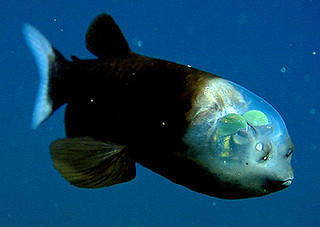By Emma Goldberg
If you’ve ever woken up in the middle of the night and tried to reach for something on your nightstand, you know that it takes your eyes a few minutes to adjust to the darkness. Now, imagine being a fish living in the deepest depths of the ocean – a place where hardly any light can reach – and having to search for food and predators. How do these fish and other ocean critters see the world around them without light? Like you may have guessed, deep sea fish have evolved some pretty amazing and unique ways to see, from increasing eye size to increasing the number of light sensitive proteins in their eyes.
 The first deep sea species we’re going to talk about is the silver spinyfin fish. This small, flattened, disc-shaped fish with large eyes doesn’t look very special at first appearance. However, this little fish has earned the title of “the vertebrate with the most types of visual opsins”. Opsins are light sensitive proteins that are found in the photoreceptor cells in the human retina – the light-sensitive layer of tissue of the eye. As humans, we have four types of opsins in our retinas: three in cone cells, which help us see blue, red and green; and one in rod cells, which help us see in dim light. The silver spinyfin, on the other hand, has up to 14 visual opsins in its rod cells! Researchers think that some of these opsins might help the silver spinyfin detect specific bioluminescent signals that are associated with its prey, danger or social interactions. Further, it’s possible that these rod opsins let the spinyfin differentiate color.
The first deep sea species we’re going to talk about is the silver spinyfin fish. This small, flattened, disc-shaped fish with large eyes doesn’t look very special at first appearance. However, this little fish has earned the title of “the vertebrate with the most types of visual opsins”. Opsins are light sensitive proteins that are found in the photoreceptor cells in the human retina – the light-sensitive layer of tissue of the eye. As humans, we have four types of opsins in our retinas: three in cone cells, which help us see blue, red and green; and one in rod cells, which help us see in dim light. The silver spinyfin, on the other hand, has up to 14 visual opsins in its rod cells! Researchers think that some of these opsins might help the silver spinyfin detect specific bioluminescent signals that are associated with its prey, danger or social interactions. Further, it’s possible that these rod opsins let the spinyfin differentiate color.

Barrel-eyed fish. Image Source.
Another fish with unique eyes is the barreleye fish. This small, funky-eyed fish was first described by scientists in the 1930s and, like the name suggests, has barrel-shaped eyes. These specialized eyes can collect light at the ocean depths, but they also limit the fish’s field of view. Until very recently, marine biologists thought the barreleye’s eyes were fixed in place. It’s not just the eyes of these fish that make them special; they also have a transparent, fluid-filled dome on the tops of their heads. It turns out that these tube-shaped eyes can actually rotate within the fishs’ transparent heads, allowing them to look forward at their potential prey and up to avoid becoming prey themselves!

Image Source.
The last deep sea species we’re going to talk about, and potentially my favorite one of all, is the cockeyed squid. Also known as the “strawberry squid” for its pink color, this deep sea critter has evolved a set of mismatched eyes: one is large and yellow; the other is small and black. When the squid are born, they have two eyes that are the same. Over time, however, the left eye rapidly enlarges and becomes semi-tube shaped, while the right remains small. It took scientists awhile to understand why an animal would intentionally evolve an asymmetry like this, but they finally cracked the code. Researchers from Duke University studied over 150 videos of cockeyed squid from the Monterey Bay Research Institute and found that the large eye is almost always facing upward, while the small eye faces downward. The researchers concluded that the large eye looks for the shadows of predators swimming above them, while the right eye looks downward for bioluminescent prey.
As you were reading this article, you might have become jealous of how cool these fishes’ eyesight is. And you wouldn’t be alone; scientists have been using fish as a model to figure out ways to help people who have eye diseases, such as glaucoma or certain retinopathies. As it turns out, Danio rerio, or zebrafish, share certain physiological traits with humans, one of which being their eyesight and eye anatomy. To capitalize on this biological similarity, scientists have been using zebrafish to test various drugs and compounds to figure out the most effective ways to treat these diseases in humans. So, we can both admire and thank these fish and many more for their unique & visionary eyesight!
